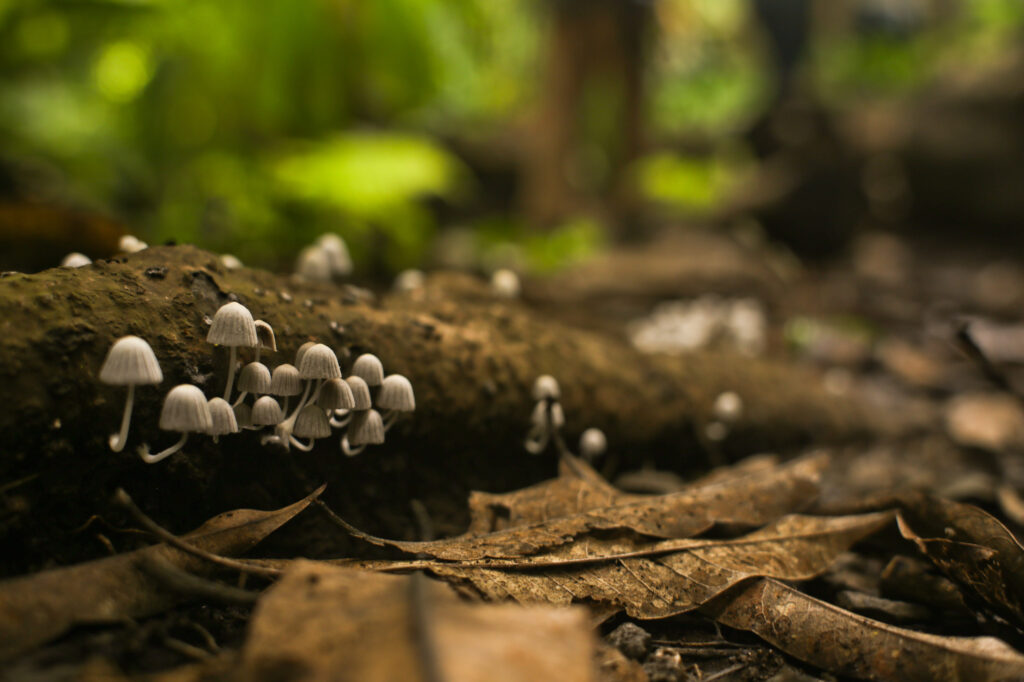
Honoring the Full Cycle of Life
“Director’s Notes” are excerpts from our monthly email newsletter, “Stories from the Garden.” Subscribe and see past issues here.
Dear Friends,
A few days ago, walking with new friends down in the valley by the old mango trees, we stopped to visit a Kerriodoxa elegans. Each time I walk in the palm garden, I feel compelled to stop here just to marvel at the dark, almost black leafstalk and deep green leaves, shimmering silver beneath. But on this afternoon in the valley we were almost equally captivated by the large pile of decaying fronds just on the other side of the path. For decades, W.S. Merwin dragged fallen fronds to carefully placed stacks he called bio-piles, and they’ve risen up over the decades. Never did a frond leave the garden; William hauled each one to a bio-pile, where it would return to the earth, honoring the full cycle of life; palms enrich the soil, enriched soil nurtures new palms. On this day, I touched the tip of my bamboo walking stick to the humus at the base of the stack. Rich soil spilled out onto our path, teeming with new life.
Particularly now, in these first rain-soaked days of the wet season, it’s hard to conjure an image of this valley as William first saw it. He has often described his gestures toward the land in those early days as “like trying to plant on a dirt road.” Where once a stream flowed to the ocean and supported so many kinds of life, an era of deforestation and overgrazing, and finally a failed attempt at planting pineapple left the land depleted. Recently I came across an interview with William* in which he lingers on what unfolded afterward here in Peʻahi, as this place welcomed his curiosity, found its way toward renewal, and then evolved well beyond his participation:
You can’t plant a forest, only a forest makes a forest, because a forest is not just a few trees. It’s a huge ecosystem of many related things that we can’t even begin to understand. It changes. There’s a point where it begins to take over and do it itself. That’s so moving when you begin to see that. Most people don’t even recognize that is what is happening, but that’s what’s happening. It’s there, the earth has it.
He goes on:
What I mean by our human arrogance is that we think the universe somehow owes us eternal life right here on earth, and that’s not so. The universe doesn’t owe us a damn thing; the universe doesn’t even notice us. This can sound like a depressing viewpoint, but I think it’s an exhilarating viewpoint. Accept your place in this incredible, incomprehensible richness of life, but also accept the unknown in the universe. We’re part of it and it’s miraculous. How did it ever happen that we should be here?
These days, as rich soil and hints of future growth tumble from the bio-piles, I too am feeling the exhilaration of what lay beyond our comprehension and control, and beyond the scope and duration of our lives. As the garden changes by the minute and renews itself beyond our doing, it extends yet another invitation to us to take up our integral–not exceptional—role in caring for the earth.
In the last pages of Carrie Fountain’s recently published children’s book The Poem Forest, she writes “When he got very old, William Stanley found he had one more promise to keep. He and Paula wanted to make sure someone would be there after they were gone, to plant the seeds and care for the palms and to keep the promise they’d made to the earth all those years ago. And so they gave their forest away.” William and Paula released what they held most dear, entrusted it to perpetual change, to itself. Yet the promise—to be an integral part of its miraculous unfolding—abides through our collective care. I feel such gratitude to be keeping this promise alongside all of you.
With warm wishes to you and yours,
Sonnet
* “Nature, Conservation, and the Unseen: A Conversation with W.S. Merwin.” Weber—The Contemporary West 30.1 (Fall 2013): 50-60. Collected in Conversations with W.S. Merwin (University Press of Mississippi, 2015).